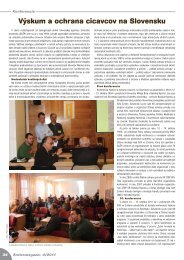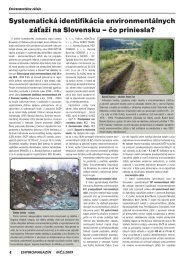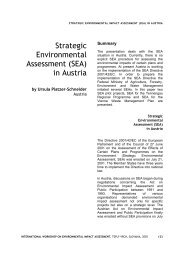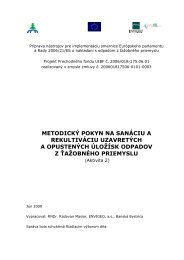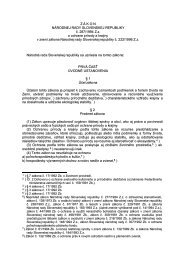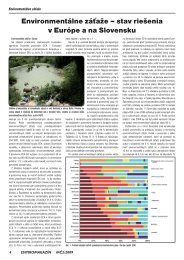Annex I - âDescription of Workâ - Hlandata
Annex I - âDescription of Workâ - Hlandata
Annex I - âDescription of Workâ - Hlandata
Create successful ePaper yourself
Turn your PDF publications into a flip-book with our unique Google optimized e-Paper software.
CIP-ICT PSP-2009-3Pilot BHLANDATARegarding the technical implementation <strong>of</strong> the HLANDATA Project, there exist some risks to betaken into account, which will have to be contemplated in the frame <strong>of</strong> a risk management plan. Forinstance, the proposed harmonization model may be difficult to implement as related to the availableinformation for the development <strong>of</strong> the 3 pilot projects. This issue may be solved by adapting thestructure <strong>of</strong> the pilot project available data to the already defined model. This may imply an increase<strong>of</strong> the foreseen costs which would have to be compensated through an adjustment <strong>of</strong> the overallproject budget.Other hypothetical setbacks to be overcome could be the withdrawal <strong>of</strong> a key expert from a member <strong>of</strong>the Consortium, or even the justified withdrawal <strong>of</strong> a partner. In the first case, the missing expertwould have to be substituted by another person from the same organization, whereas in the secondcase, the necessity <strong>of</strong> searching for another partner (depending on the punctual situation <strong>of</strong> the projectand on the particular role <strong>of</strong> the missing partner within the Consortium) would have to be analyzed.Moreover, some <strong>of</strong> the partners could fail to fulfil their expected tasks within the correspondingdeadlines. In such case, the mechanisms described at the Consortium Agreement would have to beaccordingly launched.It is especially important to ensure an adequate participation <strong>of</strong> the final users from the beginning <strong>of</strong>the project. Communication failures, lack <strong>of</strong> involvement from the partners’ side, changingrequirements, among others, could lead to unjustified delivery delays. The inclusion <strong>of</strong> a set <strong>of</strong> veryheterogeneous (or very numerous) final users within the Consortium could also entail greaterdifficulties when trying to harmonize their respective necessities. In addition, a validation plan for thefinal products, involving a wide enough amount <strong>of</strong> well-capable validators should be set out.As for the expertise and experience <strong>of</strong> the appointed work team <strong>of</strong> the project, main risks would berelated to the amount <strong>of</strong> personnel dedicated to the project, as well as their degree <strong>of</strong> involvement,their degree <strong>of</strong> awareness <strong>of</strong> the common and homogeneous objectives for the project, and also thehypothetical unexpected effect <strong>of</strong> the personnel rotation within the different work teams.From a technological point <strong>of</strong> view, different databases, whose functionalities and results have neverbeen proved yet, have been foreseen to interact together, which constitutes an added risk for thetechnological success <strong>of</strong> the project. A specific user interface will be required, new harmonizedutilities will have to be developed, new development tools will have to be integrated, and usersinteraction issues will also have to be contemplated, resulting in many possible causes for the rise <strong>of</strong>technological contingencies.During the mass production process, the main risks for the project will be associated to the clearnessand strictness <strong>of</strong> the defined development plan, as well as <strong>of</strong> the normalization and follow-up policiesapproved. The degree <strong>of</strong> knowledge <strong>of</strong> the standards and the methodology <strong>of</strong> the required technicalreviews will also turn out to be crucial in order to avoid risks and face any incidence at this point.Another incidental possibility to be considered could be the lack <strong>of</strong> continuity <strong>of</strong> the project once ithad been completed. However, this is not a realistic situation to be contemplated, since the existence<strong>of</strong> a consistent Viability and Exploitation plan for the project flatly disables such a possiblecontingency.In addition, the risk management plan for the project must also contemplate the possible risksassociated to the foreseen implementation <strong>of</strong> the pilot projects. For pilot project 1, the harmonizationmodel elaborated at WP2 may not adjust properly to the content <strong>of</strong> the data to be included within suchpilot project. As already considered, this contingency could be solved by modifying the structure <strong>of</strong>the original data and by adapting it to the proposed model.Another risk to be taken into account would be the fact that some functionalities included within pilotproject 1 could show themselves to be more difficult to implement than expected, giving rise to delaysand increases <strong>of</strong> the foreseen expenses. A possible solution for this would be to try to make use <strong>of</strong>23/03/10 v11 51



